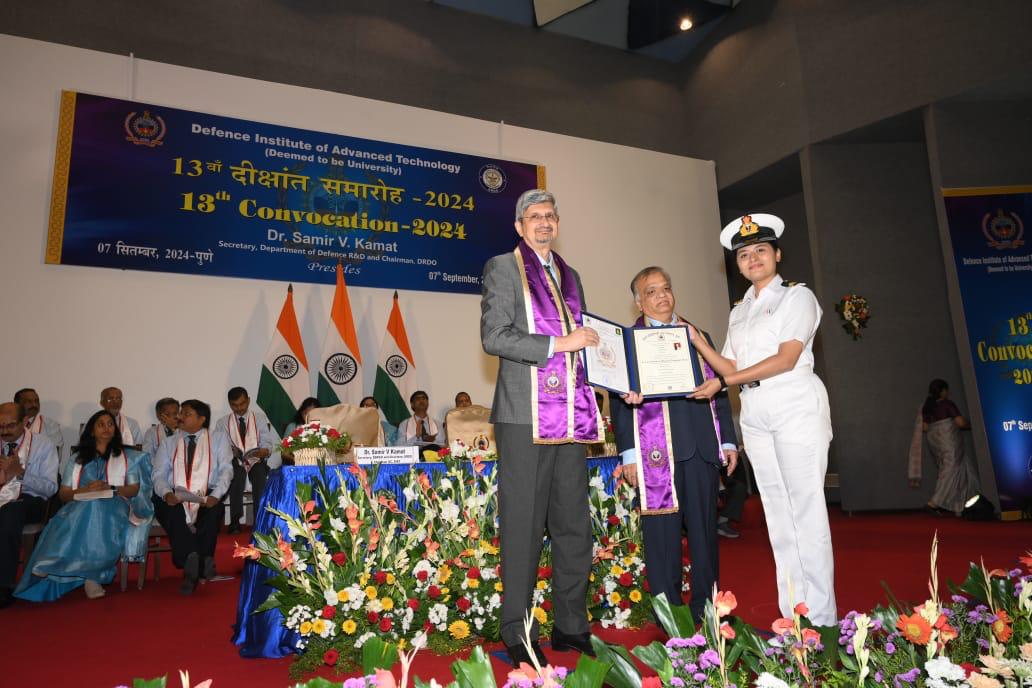Click here to join Express Pune WhatsApp channel and get a curated list of our stories
Indian Navy’s Scorpene submarine to get strategically critical Air Independent Propulsion by 2026: DRDO chairperson
The Indian Navy has both conventional and nuclear submarines in its arsenal.
 In his convocation address, Kamat said, "Any journey in defence research and development is going to be complex.
In his convocation address, Kamat said, "Any journey in defence research and development is going to be complex.Chairperson of the Defence Research and Development Organisation (DRDO) Dr Samir V Kamat said on Saturday that the indigenously developed and strategically critical Air Independent Propulsion (AIP) system, which significantly enhances the submerged endurance of a diesel-electric submarine, will be installed on the Indian Navy’s scorpene submarine by 2026.
Kamat was delivering the convocation address at the 13th convocation of the Defence Institute of Advanced Technology (DIAT), the premier research and academic establishment of the Ministry of Defence in Pune’s Girinagar area.
A total of 271 students graduated from the DIAT which included 225 with Master of Technology, 22 Master of Science (MSc), one Master of Science (MS) by research and 23 with PhDs. The passing out students included several serving officers of the Indian Army, Navy, Air Force, Coast Guard along with civilian students.
The DIAT is involved in the development of indigenous contemporary defence related technologies in advanced sensing, radar technology, data science, quantum communications, energy and environmental systems, mechanical and aerospace systems, laser and optical systems, cyber security, artificial intelligence and weapon systems for DRDO and defence services.
In his convocation address, Kamat said, “Any journey in defence research and development is going to be complex. It will require not to work individually but work in teams and in collaboration. Only then will you be able to achieve anything significant.”
 Kamat in his address said, “As an organisation, at DRDO, we are now looking at how to transform ourselves to meet the emerging challenges.
Kamat in his address said, “As an organisation, at DRDO, we are now looking at how to transform ourselves to meet the emerging challenges.
Giving an example of how success can be achieved with teamwork, Kamat said, “We have a small laboratory, Naval Materials Research Laboratory at Ambernath. It is a small facility that consists of around 70 scientists. They started a scientist and technology project sometime in the early 2000s to make fuel cells…they developed a phosphoric acid fuel cell of one kilowatt as demonstration. From that small fuel cell, we have demonstrated a land-based prototype of an air independent propulsion system, which can deliver more than 200 kilowatt of power to a conventional diesel electric submarine.”
Kamat added, “Today I can proudly say that we are only the third country which has developed this capability. When the Indian Navy’s P75 scorpene submarine comes for refit in 2026, this AIP is going to be inserted by cutting the submarine and it will improve the capabilities of our conventional submarines significantly. A submarine’s success lies if it does not resurface because if it does, then it gets detected. So if submarines can stay submerged for a long time which the AIP allows you to, your success rate improves dramatically and it gives significant capabilities to our Navy. The point I also want to make is you can dream big even if you are small.”
The Indian Navy has both conventional and nuclear submarines in its arsenal. The fleet of conventional submarines use the diesel-electric engines, which require them to surface almost daily to get atmospheric oxygen for fuel combustion. With the Air Independent Propulsion (AIP) system on board, these submarines will be required to surface much less frequently, thus increasing their lethality and stealth multifold. The successful tests of the AIP prototype have been conducted in 2019 and 2021.
While nuclear-powered submarines are considered as key assets for deep-sea operations, the conventional diesel-electric ones are vital for the coastal defence and operations close to the shore. Indigenously developed AIP, which is one of the key missions of the NMRL, is considered as one of the ambitious projects of the DRDO for the Navy. The project aims at fitting the technology on India’s Scorpene class submarine INS Kalvari.
Kamat further said in his address, “As an organisation, at DRDO, we are now looking at how to transform ourselves to meet the emerging challenges. You are aware that the world is going through a geopolitical and geo-strategic churn…The way things are emerging, India is going to become one of the major poles in the multipolar world that is shaping…A lot of disruptive technologies are emerging which are changing the way wars are being fought We are also seeing how to adapt to the emerging world order.”
Click here to join Express Pune WhatsApp channel and get a curated list of our stories













